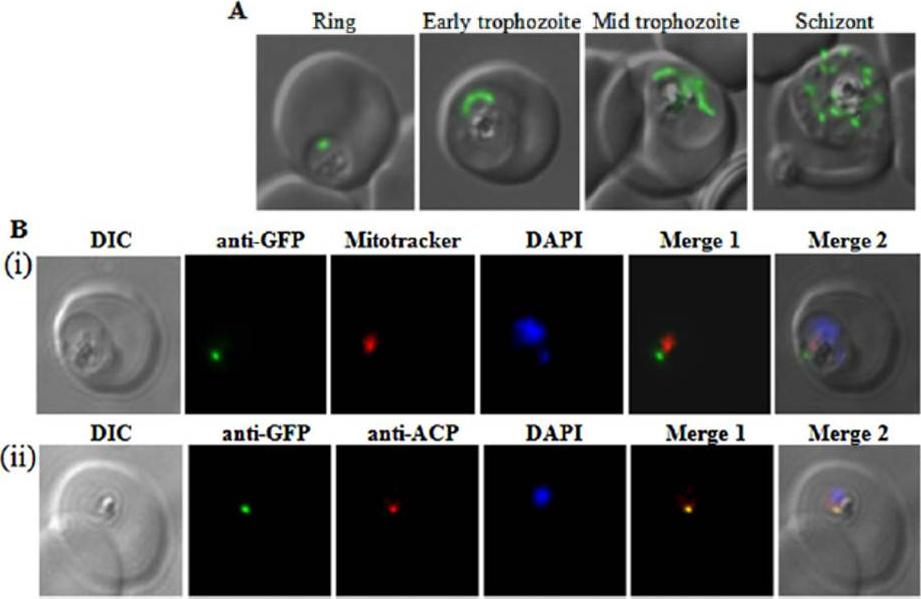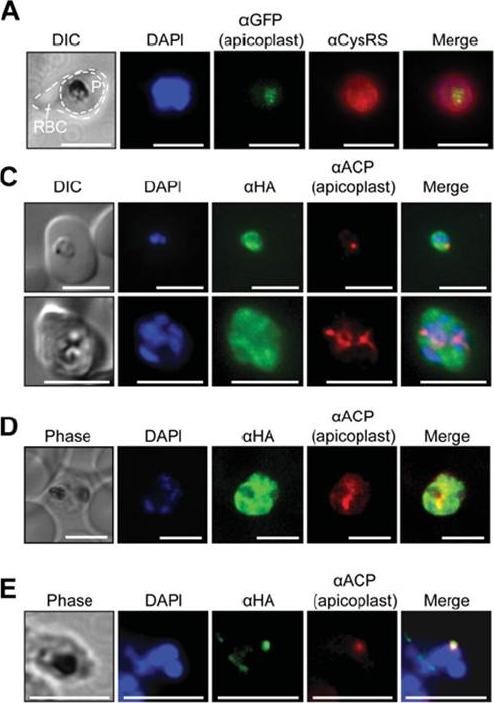PCHAS_0307900 ribosome-recycling factor, putative (RRF1)
Disruptability [+]
| Species | Disruptability | Reference | Submitter | |
|---|---|---|---|---|
| P. berghei ANKA |
Refractory |
PlasmoGEM (Barseq) | PlasmoGEM | |
| P. falciparum 3D7 |
Refractory |
USF piggyBac screen (Insert. mut.) | USF PiggyBac Screen | |
Mutant phenotypes [+]
None reported yet. Please press the '+' button above to add one.Imaging data (from Malaria Metabolic Pathways)

PfRRF1 localizes to the apicoplast.A. Live cell images of PfRRF1leader–GFPtransfected parasites at different stages of the erythrocytic cycle. Signals indicative of apicoplast morphology are seen in the ring,trophozoite and schizont stages.B. Immunolocalization of PfRRF1. Panel (i) shows a differential interference contrast (DIC) image, nuclear DNA staining with DAPI, PfRRF1leader–GFP fluorescence, MitoTracker signal, and their overlap. Panel (ii) showscolocalization of PfRRF1leader–GFP and the apicoplast marker ACP.Gupta A, Mir SS, Jackson KE, Lim EE, Shah P, Sinha A, Siddiqi MI, Ralph SA, Habib S. Recycling factors for ribosome disassembly in the apicoplast andmitochondrion of Plasmodium falciparum. Mol Microbiol. 2013 88(5):891-905.
See original on MMP
(A) Immunofluorescence assays of trophozoite stage P. falciparum (3D7 strain) using an anti-Pf CysRS antibody, DAPI and the apicoplast marker PfRRf1–GFP. The red blood cell is indicated (RBC) and the parasite is indicated (P). (C) Epifluoresence microscopy and (D) confocal imaging of immunofluorescence analysis of Pf CysRS–HA transfectants at early- and late-trophozoite stage parasites (top and bottom panels respectively) with an anti-HA antibody against the Pf CysRS–HA enzyme, ananti-ACP antibody for the apicoplast, and DAPI for the nucleus. The images show that the Pf CysRS–HA is distributed throughout the cytosol, and also overlap with the apicoplast marker ACP. The width of the apicoplast is less than the spatial resolution of light microscopy, sowe cannot definitively assign co-localization from these experiments. (D) Confocal images of Pf CysRS–HA transfectant parasites at late-trophozoite stage using indirect immunofluorescence analysis reveals cytoplasmic distribution ofPf CysRS–HA overlapping with the apicoplast marker ACP. (E) Immunofluorescence analysis with saponin-treated Pf CysRS–HA to differentially lysemembranes to allow for visualizing subcellular organelles with antibodies and stains as indicated. Parasites are labelled with an anti-HA antibody against the Pf CysRS–HA enzyme, and an anti-ACP antibody as a marker of the apicoplast. This immunolocalization confirms that afraction of Pf CysRS is specifically retained within the apicoplast. All scale bars indicate 5 μm.Pham JS, Sakaguchi R, Yeoh LM, De Silva NS, McFadden GI, Hou YM, Ralph SA. A dual-targeted aminoacyl-tRNA synthetase in Plasmodium falciparum charges cytosolic and apicoplast tRNACys. Biochem J. 2014 458(3):513-23
See original on MMPMore information
| PlasmoDB | PCHAS_0307900 |
| GeneDB | PCHAS_0307900 |
| Malaria Metabolic Pathways | Localisation images Pathways mapped to |
| Previous ID(s) | PC000449.00.0, PC101962.00.0, PC404243.00.0, PCAS_030790, PCHAS_030790 |
| Orthologs | PBANKA_0305700 , PF3D7_0208600 , PKNH_0412500 , PVP01_0416200 , PVX_003885 , PY17X_0306300 |
| Google Scholar | Search for all mentions of this gene |